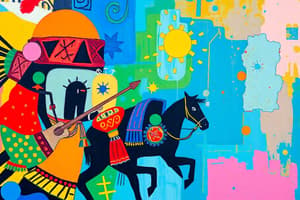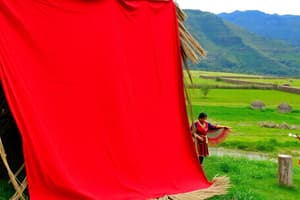Podcast
Questions and Answers
Which term refers to the hybrid religious practices created by indigenous groups to coexist with Roman Catholicism?
Which term refers to the hybrid religious practices created by indigenous groups to coexist with Roman Catholicism?
- Anitos (correct)
- Kamalig
- San Pascual Baylon
- Bulul
How did the Ifugao integrate their deity, bathalud, into Catholic feasts?
How did the Ifugao integrate their deity, bathalud, into Catholic feasts?
- As a warrior deity
- As a protector of livestock
- As a guardian of rice terraces (correct)
- As a symbol of fertility
Which indigenous group linked the saint San Pascual Baylon to their deity Kamalig as a protector of livestock?
Which indigenous group linked the saint San Pascual Baylon to their deity Kamalig as a protector of livestock?
- Tingguian
- Ilocano
- Subanen
- Ifugao (correct)
How did some indigenous groups in Cordilleras and northern Luzon adapt to the changing world while preserving their cultural identity?
How did some indigenous groups in Cordilleras and northern Luzon adapt to the changing world while preserving their cultural identity?
What role did religion play in the resistance efforts of indigenous groups in Cordilleras and northern Luzon?
What role did religion play in the resistance efforts of indigenous groups in Cordilleras and northern Luzon?
Which term best describes the collaboration between some indigenous peoples and Spanish colonizers in preserving their cultures?
Which term best describes the collaboration between some indigenous peoples and Spanish colonizers in preserving their cultures?
What was one method used by indigenous communities in the Cordilleras to preserve their culture?
What was one method used by indigenous communities in the Cordilleras to preserve their culture?
Which of the following best describes the approach of indigenous groups towards their distinct dress and architecture during Spanish colonization?
Which of the following best describes the approach of indigenous groups towards their distinct dress and architecture during Spanish colonization?
In the face of Spanish colonization, what was a key focus of the indigenous resistance efforts in the Cordilleras and northern Luzon?
In the face of Spanish colonization, what was a key focus of the indigenous resistance efforts in the Cordilleras and northern Luzon?
How did indigenous communities in the Cordilleras resist assimilation into Spanish society?
How did indigenous communities in the Cordilleras resist assimilation into Spanish society?
What role did religion play in the resilience of indigenous groups in the Cordilleras against Spanish colonization?
What role did religion play in the resilience of indigenous groups in the Cordilleras against Spanish colonization?
Why did some indigenous communities in the Cordilleras choose to relocate to remote areas during Spanish colonization?
Why did some indigenous communities in the Cordilleras choose to relocate to remote areas during Spanish colonization?
Study Notes
Indigenous Resistance in Cordilleras and Northern Luzon: Culture and Religion
In the face of Spanish colonization, communities in the Cordilleras and northern Luzon found themselves caught in a battle for survival, not only against the oppressive regime but also to protect their unique cultures and traditional beliefs. The indigenous groups in this region displayed remarkable resilience, turning to both cultural preservation efforts and the power of religion to oppose, endure, and persist through centuries of change.
Culture Preservation Efforts
The Cordilleras, a mountainous region in the northern Philippines, is home to a diverse array of indigenous peoples. The Ifugao, Kalinga, Ilocano, and other ethnic groups held deep-rooted connections to their land, resources, and traditions. They fought to safeguard their identity, language, and way of life against the encroaching onslaught of the Spanish colonizers.
To preserve their culture, indigenous communities employed a variety of methods. They retold their myths, legends, and oral histories, passing them down through generations to ensure their survival. They also resisted forced assimilation into Spanish society, retaining their distinct dress, architecture, and farming practices. In some cases, they even chose to relocate to remote areas, seeking refuge in the inaccessible portions of their ancestral lands.
Role of Religion
Religion played a vital role in the resistance efforts of indigenous groups in the Cordilleras and northern Luzon. Traditional beliefs and practices, in some cases, were in direct opposition to the Catholic faith imposed by the Spanish colonizers. In response, indigenous groups adapted their beliefs to coexist alongside Roman Catholicism, creating hybrid religious practices known as anitos, bulul, or amalan.
These deities and rituals represented the indigenous peoples' efforts to remain connected to their traditional beliefs while also respecting the Catholic religion. For example, the Ifugao, known for their intricate rice terraces, integrated their deity, bathalud, into Catholic feasts to ensure the continuity of their agricultural practices.
Moreover, indigenous peoples integrated the Christian saints into their traditional belief systems, adapting them to their local contexts. The Ifugao, for example, linked the saint San Pascual Baylon to their own deity, Kamalig, as a protector of livestock.
Collaboration and Coexistence
Indigenous resistance in the Cordilleras and northern Luzon was not always combative. In some cases, indigenous peoples collaborated with the Spanish colonizers to safeguard their cultures and communities. For instance, the Ilocano people, facing Spanish rule, initially welcomed friars to their communities, hoping to learn and benefit from the new religion. However, this collaboration soon gave way to resistance as the indigenous peoples realized the religious and cultural threats posed by the Spanish colonizers.
Some indigenous groups, such as the Subanen and Tingguian, actively coexisted with the Spanish colonizers. They accommodated the new culture and religion, while also preserving their traditional beliefs. In this way, they were able to maintain their cultural identity and adapt to the changing world around them.
Conclusion
The indigenous peoples of the Cordilleras and northern Luzon faced significant challenges during the Spanish colonial period. Despite the hardships, they displayed remarkable resilience and adaptability. Through cultural preservation efforts and the integration of religion, they managed to maintain their identity and traditions while also coexisting with the Spanish colonizers. The indigenous peoples of this region continue to be an essential part of the Filipino fabric, and their history serves as a testament to the strength and resilience of their cultures.
Studying That Suits You
Use AI to generate personalized quizzes and flashcards to suit your learning preferences.
Description
Test your knowledge on the indigenous resistance in Cordilleras and northern Luzon against Spanish colonization, focusing on culture preservation efforts and the role of religion. Explore how indigenous groups in the Philippines protected their unique cultures, traditions, and beliefs amidst external threats.




